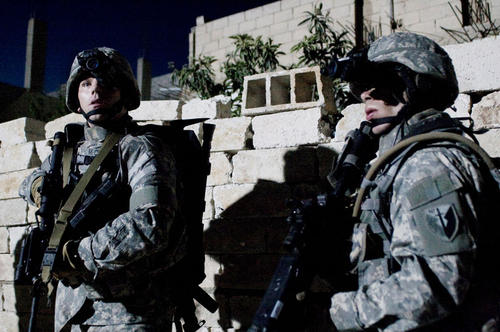How Moving Pictures Move Audiences
Within the project “The mobilization of emotions in war films” in the Languages of Emotion cluster of excellence, film scholars study the interaction between movement on the screen and the viewer’s emotions.
Feb 29, 2012
Fear in their eyes: How are emotions aroused in viewers? A scene from the U.S.-Canadian production “Redacted,” produced by film director Brian De Palma during the war in Irak.
Image Credit: Magnolia Pictures
The scholars working on the project watched more than 30 Hollywood war movies produced from the 1940s up to the present day, from Gung Ho!, Bataan, and Sahara, all released in 1943 and all centering on World War II, to Jarhead and Redacted, which deal with the Gulf War, in 1990–91, and the 2003 Iraq War, respectively, both of which were filmed after the start of the new millennium. The film scholars watched a number of scenes up to 20 times. That might be enough to give ordinary viewers nightmares of tanks, gunfire, and casualties – but not the scholars, who take a purely analytical view. “We aren’t all that interested in the message behind these war movies. Instead, we have developed a tool that can be used to categorize this genre along the lines of specific affect areas and stereotypes,” says project participant Anna Steininger.
“Affect areas” – by that she means broad emotions such as sadness, anger, and fear, feelings that the viewer experiences. In the model used by the scholars, stereotypes are plot elements echoed in almost all films, such as fighting and technology, soldiers saying goodbye to their wives and deploying, going through suffering and sacrifice – classic scenes intended to evoke certain emotions among viewers. Under the leadership of film scholar Professor Hermann Kappelhoff, the researchers established the term “expressive movement” for this interplay between acoustic and visual moving images and viewer perceptions – a concept that combines psychology, anthropology, and art studies. What is presented in the film is perceived directly by the viewer. That perception takes place on a temporal level, triggered by changing images, editing, and camera angles. Films are composed in minute detail, like a piece of music; in this project, the film scholars took on the task of laying out a methodological approach to penetrating this complex construction.
First, groups of three participants each viewed one film and used a standardized guideline to break it down into various scenes and time units, dubbed “standard scenes.” “In these records, assignment to the various categories of scenes averaged an 80 percent match,” Steininger says. Then researchers enter stereotypes and affect areas in diagrams developed specifically for this purpose, making it clear at a glance at what time which stereotypical topic overlaps with which emotion among viewers. Then the films are divided into units, some of them just a few minutes long, and the expressive movements are analyzed and described according to pre-specified criteria.
“This method can be used to analyze more than just the genre of war films. Instead, our methodology is applicable to all film genres,” says Kappelhoff. “We have developed an analytical model that can be used to examine and describe films as a movement in the perceptions and feelings of viewers.” The results of the research work, descriptions of scenes, and diagrams are available, together with clips from the films, in a research database accessible on the Internet.
The researchers have now moved on to a new project, this time focusing on comparing genre films with war reporting in various media formats, from the masterful – but propagandistic – documentaries made by Leni Riefenstahl for the Nazi party to YouTube videos of the Iraq War.
Further Information
- Anna Steininger, Languages of Emotion Cluster of Excellence, Email: anna.steininger@fu-berlin.de
- Prof. Dr. Hermann Kappelhoff, Film Studies, Freie Universität Berlin, Tel.: +49 (0)30 838-503 78, Email: sekretariat-kappelhoff@fu-berlin.de

